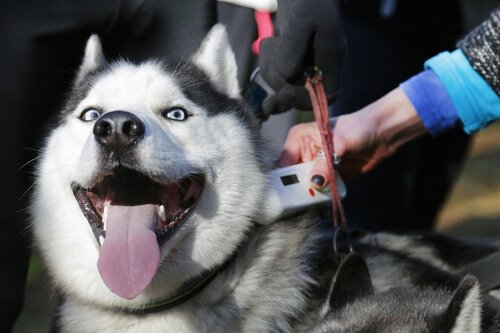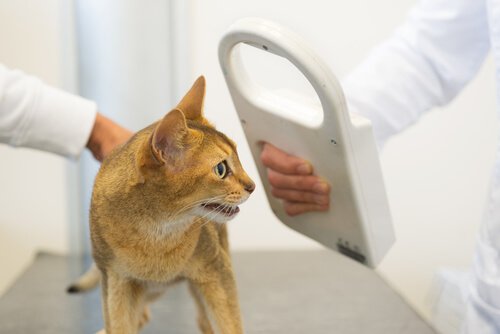What Do Microchips for Pets Do?


Written and verified by the lawyer Francisco María García
If a pet with a microchip is lost, abandoned or stolen, and someone takes him to a shelter or veterinarian’s, they can identify him immediately. Keep reading to find out all about microchips for pets.
What is a microchip?
Microchips for pets are an electronic identification system for animals that are generally made up of two parts: one is the microchip itself and the other is a covered capsule. This capsule is a soft and biocompatible glass (non-allergenic) and is as small as a grain of rice.
How to implant the microchip for pets

Veterinarians can insert the microchip into your pet. The expert will implant the capsule into the animal’s body, at neck height. He’ll do this using an injector that enters it into their skin.
Each of these chip devices has an individual set of number codes, so it’s kind of like an ID for the animal.
The vet only has to insert the chip into the pet once during his lifetime and it will stay in his body forever. They will then put the dog’s or cat’s information in the Canine Census database of the area. This database stores the chip’s information (owner’s name, address and one or two contact numbers).
Ideally, you should get your dog this chip when he’s between one and a half and two months old.
The accuracy of the data
It’s very important that you provide the vet with accurate information. Remember, this information will be recorded in the database and will be used if you lose your pet.
If the owner changes his address, he should contact the veterinarian immediately. Then, the vet will have him sign the necessary forms in order for them to make the changes in the database. For legal purposes, the animal’s owner is the contact in the database. He’ll also be the one responsible for any damage the pet may cause.
Of course, when the pet dies, we also have to communicate this to the vet and sign the necessary documents.
Usefulness of microchips for pets
There are many advantages to getting your pet a microchip:
- First, it’s the legal recognition that we own our pet; the data in the microchip can’t be falsified.
- If you lose your animal then veterinarians, shelters and authorities can access the data through a reader.
- Chips help avoid abandonment, because the law punishes people who abandon or mistreat animals with very high penalties. That way, the authorities will know who is the owner and legal guardian of a beaten or abandoned animal.
In the cases of loss or theft…

The quickest way to identify a dog or another pet that’s lost is to notify the local police, or any other official animal protection body in your area.
When addressing a letter to these organizations and entities, make sure you indicate the chip number and the animal’s name, as well as any other information that you might know, as well as the date and location where you found the dog, or where you last saw him.
The content of the law
In some countries, like Spain, the law requires identification of all cats and dogs. You’ll have to find out if this is a legal requirement in your area or country. However, even if it isn’t, it’s always a good idea for your pet to have a microchip.
If a pet with a microchip is lost, abandoned or stolen, and someone takes him to a shelter or veterinarian’s, they can identify him immediately. Keep reading to find out all about microchips for pets.
What is a microchip?
Microchips for pets are an electronic identification system for animals that are generally made up of two parts: one is the microchip itself and the other is a covered capsule. This capsule is a soft and biocompatible glass (non-allergenic) and is as small as a grain of rice.
How to implant the microchip for pets

Veterinarians can insert the microchip into your pet. The expert will implant the capsule into the animal’s body, at neck height. He’ll do this using an injector that enters it into their skin.
Each of these chip devices has an individual set of number codes, so it’s kind of like an ID for the animal.
The vet only has to insert the chip into the pet once during his lifetime and it will stay in his body forever. They will then put the dog’s or cat’s information in the Canine Census database of the area. This database stores the chip’s information (owner’s name, address and one or two contact numbers).
Ideally, you should get your dog this chip when he’s between one and a half and two months old.
The accuracy of the data
It’s very important that you provide the vet with accurate information. Remember, this information will be recorded in the database and will be used if you lose your pet.
If the owner changes his address, he should contact the veterinarian immediately. Then, the vet will have him sign the necessary forms in order for them to make the changes in the database. For legal purposes, the animal’s owner is the contact in the database. He’ll also be the one responsible for any damage the pet may cause.
Of course, when the pet dies, we also have to communicate this to the vet and sign the necessary documents.
Usefulness of microchips for pets
There are many advantages to getting your pet a microchip:
- First, it’s the legal recognition that we own our pet; the data in the microchip can’t be falsified.
- If you lose your animal then veterinarians, shelters and authorities can access the data through a reader.
- Chips help avoid abandonment, because the law punishes people who abandon or mistreat animals with very high penalties. That way, the authorities will know who is the owner and legal guardian of a beaten or abandoned animal.
In the cases of loss or theft…

The quickest way to identify a dog or another pet that’s lost is to notify the local police, or any other official animal protection body in your area.
When addressing a letter to these organizations and entities, make sure you indicate the chip number and the animal’s name, as well as any other information that you might know, as well as the date and location where you found the dog, or where you last saw him.
The content of the law
In some countries, like Spain, the law requires identification of all cats and dogs. You’ll have to find out if this is a legal requirement in your area or country. However, even if it isn’t, it’s always a good idea for your pet to have a microchip.
This text is provided for informational purposes only and does not replace consultation with a professional. If in doubt, consult your specialist.








